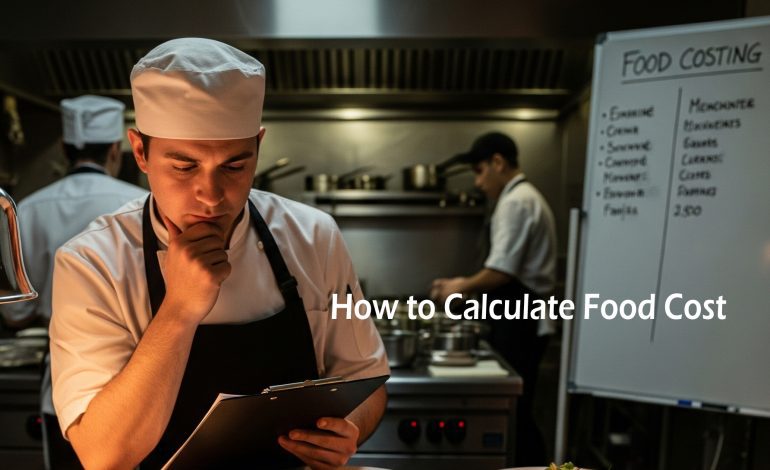How to Calculate Food Cost in 2025 (The Ultimate Guide with Examples)

Pricing your menu can feel like walking a tightrope. Price too high, and customers might turn away. Price too low, and your profit margins take the hit. The secret? Understanding your food cost percentage.
This single metric tells you how much you’re spending on ingredients compared to how much you’re bringing in. Done right, it becomes the foundation for smarter pricing, healthier profits, and a more sustainable restaurant.
In this guide, we’ll break down everything you need to know about food cost percentage, why it matters, how to calculate it, and practical strategies to keep it under control. We’ll also give you a free food cost calculator to make the math easier.
📌 What You’ll Learn
- What Is Restaurant Food Cost?
- What Is Food Cost Percentage?
- Why Calculating Food Cost Percentage Is Important
- What Is Considered a Good Food Cost Percentage?
- How to Calculate Food Cost Percentage (Step-by-Step Example)
- What Is an Ideal Food Cost Percentage?
- Food Cost Per Serving (and How to Calculate It)
- How to Calculate Ideal Menu Prices
- Potential Outcomes of Menu Price Changes
- How to Lower Food Cost
- How to Manage Food Waste
- Free Food Cost Calculator
- FAQs
🍽️ What Is Restaurant Food Cost?
Food cost is the amount you spend on ingredients to prepare each dish. It can be tracked at the dish level (to see which menu items are profitable) or at the restaurant level (to measure overall performance).
Many operators use food cost alongside Cost of Goods Sold (COGS), which includes every consumable expense — from garnishes to napkins.
📊 What Is Food Cost Percentage?
Food cost percentage is the ratio of food expenses to food sales, expressed as a percentage.
There are two ways to look at it:
- Per Dish: How much each dish costs to make vs. how much it sells for.
- Total Restaurant: Total food expenses compared to total sales over a given time frame.
This metric helps you set menu prices, optimize profitability, and identify problem dishes.
💡 Why Is Food Cost Percentage Important?
- Identify which dishes are profitable and which need improvement.
- React quickly to ingredient price changes.
- Establish benchmarks to keep costs consistent.
- Avoid losing revenue without realizing it.
👉 Example: Burger King sells 16.7M burgers daily. If their food cost is off by just $0.01 per burger, that’s $61M lost per year.
For smaller restaurants, the same principle applies — an unchecked food cost percentage can mean tens of thousands in lost profits annually.
✅ What Is a Good Food Cost Percentage?
Industry benchmarks suggest:
- Quick service restaurants (QSRs): 28–30%
- Full-service / fine dining: 30–35%
Your target depends on your concept, menu, and operating costs.
🧮 How to Calculate Food Cost Percentage
Here’s the formula:
Food Cost Percentage = (Beginning Inventory + Purchases – Ending Inventory) ÷ Total Food Sales
Example: Pizza Kitchen & Café
- Total food sales: $12,500
- Beginning inventory: $13,250
- Purchases: $4,400
- Ending inventory: $12,200
Food cost percentage = (13,250 + 4,400 – 12,200) ÷ 12,500
= 5,450 ÷ 12,500
= 43.6%
👉 At 43.6%, this café is way above the industry standard, signaling the need for menu price adjustments or ingredient cost reductions.
🎯 What Is an Ideal Food Cost Percentage?
For most restaurants, the ideal range is 28–32%.
Example (Pizza Kitchen & Café again):
- Food cost: $3,500
- Food sales: $12,500
Ideal Food Cost % = 3,500 ÷ 12,500 = 28%
Comparing the actual (43.6%) to the ideal (28%) shows a 15.6% revenue gap.
🍕 Food Cost Per Serving
Formula:
Cost Per Serving = Total Ingredient Cost ÷ Number of Servings
Example: Vegetable Pizza
- Dough (flour, yeast): $0.25
- Sauce (tomato, oil, garlic, spices): $0.40
- Toppings (peppers, onion, mushrooms, olives, spinach): $1.45
- Cheese: $0.75
Total per pizza = $3.10
💲 How to Calculate Ideal Menu Prices
Formula:
Menu Price = Food Cost Per Serving ÷ Ideal Food Cost %
Example: Vegetable Pizza
- Current cost per serving: $3.10
- Ideal food cost percentage: 28%
Menu Price = 3.10 ÷ 0.28 = $11.07
👉 If they’re charging $7.11, they’re losing almost $4 per pizza.
Selling 50 pizzas a day = $72,270 lost per year — on just one dish!
🔄 Potential Outcomes of Price Changes
- Sales stay steady (best case): Profitability improves immediately.
- Sales decline: Consider portion adjustments or supplier negotiations instead.
📉 How to Lower Food Cost
- Source cheaper suppliers.
- Adjust portion sizes.
- Redesign menus to highlight high-margin items.
- Increase carb-based or plant-forward dishes (lower ingredient cost).
- Slightly raise menu prices across the board.
🌱 How to Manage Food Waste
- FIFO inventory management (first in, first out).
- Donate safe surplus food to food banks.
- Compost scraps or repurpose leftovers.
- Label and store properly to extend shelf life.
- Educate staff on portioning and waste awareness.
❓ FAQs
Q: How often should I calculate food cost percentage?
A: Weekly is best, monthly at minimum.
Q: Can I use POS data instead of manual calculations?
A: Yes, most modern POS systems integrate inventory and sales data automatically.
Q: Is labor included in food cost percentage?
A: No, labor is tracked separately as part of “prime cost.”
✨ Bottom line:
Mastering food cost percentage in 2025 isn’t optional — it’s a survival skill. By tracking your costs, pricing strategically, and managing waste, you’ll create a menu that’s both profitable and sustainable.










